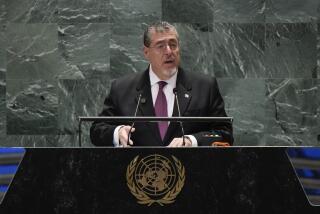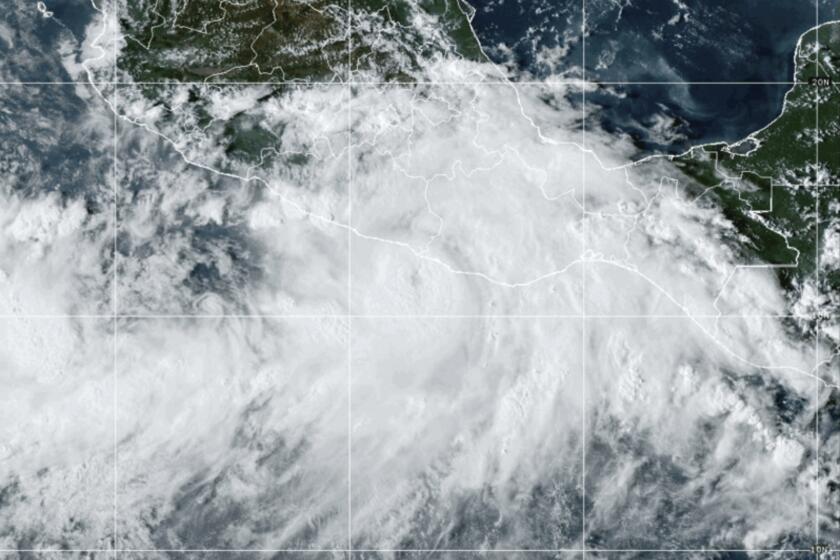Al Qaeda Link Is One Possibility
The size and savagery of Thursday’s synchronized train station bombings suggest a significant shift in tactics by Basque separatists -- or the work of an entirely new player in Spain.
Spanish authorities are wrestling with competing theories over who was responsible for the attacks that killed nearly 200 people and injured 1,400 others. Swift to blame militants of the Basque separatist group ETA fighting to secede from Spain, officials by the end of the day were forced to acknowledge that they were pursuing a more complex investigation.
Forensic evidence, including the type of explosives used, and the arrests in recent weeks of purported Basque terrorists armed with powerful bombs point to ETA as the prime suspect in Thursday’s attacks, investigators said in interviews, echoing Interior Minister Angel Acebes.
ETA purportedly had planned a Christmas Eve bombing at another Madrid train station, which was foiled by police. Recent intelligence revealed that a young, ruthless generation of Basque militants has pushed since last summer to pull off a spectacular blow, according to a senior Spanish law enforcement official.
But Thursday’s well-coordinated strikes aimed at inflicting mass civilian casualties were out of character with ETA’s three-decade-old armed campaign. ETA has traditionally targeted the symbols of Madrid’s power, such as police and politicians, or its economic base, with strikes on tourist resorts.
The methods recalled the brutal choreography refined by Al Qaeda in its Sept. 11, 2001, attacks on New York and Washington and more recently around the world.
The discovery of an Arabic audiotape along with detonators in a stolen van thought to have been used by the Madrid attackers forced investigators to consider a grim alternative scenario: Islamic terrorists may have chosen Spain for the attack in what would mark their first successful strike in Western Europe.
“We are pursuing both the possibilities of Basque terrorism and Islamic terrorism,” a Spanish police commander said. “ETA remains the stronger possibility. But these attacks were rather strange. There are elements that resemble Al Qaeda, elements resembling ETA, and some things that are neither one nor the other.”
The method of attack fed a third theory: that the coordinated strikes resulted from an alliance of Basque and Islamic networks.
In past decades, ETA’s worldwide contacts have brought it into contact with Arab militants in places such as Libya and Lebanon. Last year, attacks by suicide bombers in Morocco and Turkey showed the ability of Al Qaeda operatives to join forces with other terrorist groups.
But most investigators regard a partnership between the secular nationalists of ETA and today’s violent Islamic fundamentalists as unlikely.
Nonetheless, the calculated plan to inflict massive casualties in Thursday’s attacks suggests that the Al Qaeda terrorist network has become an influence for post-Sept. 11 terrorism and may have been copied by ETA, authorities said.
” ... They see that spectacular, coordinated attacks like those carried out by Al Qaeda are the ones that cause the most impact. So instead of killing a city councilman somewhere, they do this,” said an investigator with Spain’s paramilitary Civil Guard.
The investigator said that Thursday’s attacks had no such value. “The targets were not symbolic: just working people taking the train at 7:30 a.m.,” he said
ETA has shown its own brand of ruthlessness. One trademark, which police detected again Thursday, involves setting time bombs designed to kill police and rescue personnel arriving at the scene of an initial blast.
Attacks blamed on ETA have killed about 800 people over more than 30 years.
Normally an ETA member telephones a warning shortly before an explosion.
Before Thursday, ETA’s deadliest strike was a bombing that killed 22 people at a Barcelona supermarket in 1987. The group later apologized for killing so many civilians.
In recent years, aggressive police work has chipped away at ETA’s old guard leadership, including some veterans old enough to remember the years of the Franco dictatorship, when ETA’s fight against the regime elicited some sympathy in Spain.
The ETA old guard has been pressured by young radicals intent on reinvigorating a weakened and widely despised group, according to the senior Spanish law enforcement official.
“At the end of the summer, there was intelligence that the moderate sector had rejected pressure from the more radical ones pushing for a big massacre,” the official said.
“This is a generation ... born and raised in democracy, yet they are the most radical of all. And basically [they are] street thugs, without ideology, really brain-dead. The older ones have a certain philosophy when they talk to you, a political discourse. Not these guys,” he added.
The type of timers and the explosives used in Thursday’s coordinated attacks closely resembled some of the material used in past strikes by ETA, investigators said.
The timing of the attacks also fit with ETA’s history, coming as they did just three days before national elections.
The separatists often wait to claim responsibility after an attack, evaluating the political fallout. Because Thursday’s attacks caused such carnage, they seemed politically self-destructive, which could explain why members of ETA’s outlawed political wing declared the attacks the work of Arab terrorists.
Although investigators were dubious of those claims, they acknowledged that the style of the attacks raised the possibility that Al Qaeda or its affiliates had been involved.
Al Qaeda has been active in Spain for years. A network broken up in late 2001 was suspected of aiding the Sept. 11 hijackers. Extensive wiretaps of the network never indicated any plans for an attack in Spain, which Al Qaeda values as a transit point for activities in North Africa and Europe.
But Spain has been an aggressive partner in the U.S. war on terrorism. Prime Minister Jose Maria Aznar was a prominent supporter of the U.S. invasion of Iraq, the first anniversary of which is nearing.
In an audiotape that surfaced last fall, Al Qaeda’s Osama bin Laden singled out Spain and Italy, another staunch supporter of U.S. anti-terrorism policies, as potential targets for punishment. Several weeks later, 19 Italians, including two civilians, were killed at a garrison by a suicide bomber in Iraq.
A group calling itself the Abu Hafs al-Masri Brigades e-mailed a claim of responsibility for Thursday’s bombings to an Arabic newspaper in London, saying it was “settling old accounts with Spain, the crusader, and America’s ally in its war against Islam.”
Authorities were unsure whether to take the claim seriously.
In Washington, the State Department emphatically denied Thursday that the bombings were the work of Al Qaeda.
Department spokesman Richard Boucher said Spain believed that ETA was responsible and added that the U.S. had no evidence to indicate otherwise.
The Islamic material discovered Thursday in a stolen van in Madrid consisted of an audiocassette of verses from the Koran, an easy item to find in Islamic bookstores and shops, the Spanish police commander said.
“It’s possible, of course, that ETA could be responsible” and the tape was left there to throw authorities off the track, he said.
Rotella reported from Paris and Wilkinson from Madrid.
*
(BEGIN TEXT OF INFOBOX)
What is ETA?
* Considered a terrorist group by Spain, European Union and U.S.
* ETA stands for Euzkadi Ta Askatasuna, meaning Basque Homeland and Freedom.
* The group, founded in 1959, wants an independent state based on Marxist principles in the Basque region of northern Spain.
* Spain rejects Basque independence, but has granted the region broad autonomy, including recognition of the language.
* Kidnappings, robberies and extortion help fund ETA.
* Membership is said to be in the hundreds but the total is unknown.
* The U.S. says ETA members have gotten terrorist training in Libya, Lebanon and Nicaragua.
Source: Associated Press
Los Angeles Times
More to Read
Sign up for Essential California
The most important California stories and recommendations in your inbox every morning.
You may occasionally receive promotional content from the Los Angeles Times.











